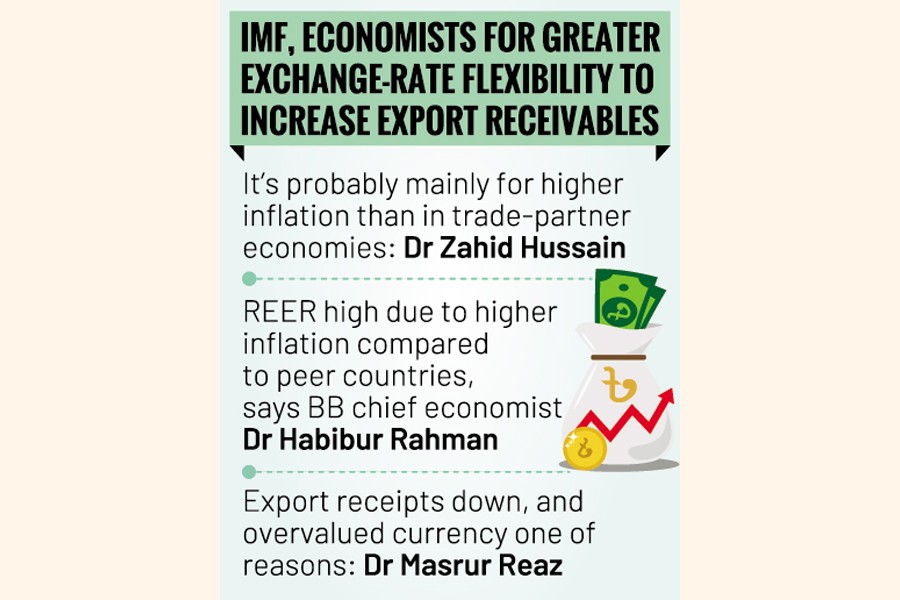JASIM UDDIN HAROON AND SYFUL ISLAM | December 20, 2023 00:00:00

Bangladesh's currency remains overvalued for long and thus dents the trade competitiveness with overseas trading partners who are enjoying economic pickup and inflation downturn, economists say.
Data show that the taka remained overpriced by more than 5.6 per cent or Tk 6.17 even though the currency had weakened more than 17 per cent since July 2022.
Such state of the domestic currency is found in an evaluation statement prepared by the central bank recently. The Bangladesh Bank regularly apprises the government of the nominal and real effective exchange rates of the taka against a 15-curreny basket.
According to the regulatory review, as of December 08, the Real Effective Exchange Rate (REER)-based exchange rate was Tk 116.42. On the other hand, the bilateral nominal exchange rate was at Tk 110.25.
In economics, REER should be 100, and at this point, trade is believed to be fully competitive. Above this mark, external trade loses competitiveness.
This gauge, REER, considers the currency and inflation of all major trading partners of Bangladesh. As per Bangladesh Bank, in measuring REER index it considers currencies and inflation readings of the top 15 trading partners.
At 100 as the constant, the REER is assumed as the equilibrium level of the exchange rate as there is no other estimation to measure it.
However, during the regime of 6.0-9.0-percent interest on the country's financial market, the taka was much more overvalued. For example, such dispersion from equilibrium was recorded as more than 14.12 between bilateral-and REER-based exchange rate during the month of April of fiscal year 2021-22.
Following a loan agreement with the IMF, Bangladesh started liberalising or conducting reforms on its foreign-exchange market. The forex market remained volatile since the beginning of the war in Ukraine in February 2022, prompting the government to put restrictions on imports.
In July this year, the dispersal came down to almost zero, the central bank data show. The REER was then recorded at Tk 109.58 and the bilateral or dollar-taka nominal- exchange rate was recorded at Tk 108.96 and so the difference between them was just Tk 0.62.
Dr Zahid Hussain, an independent economist of Bangladesh, says since the taka-dollar exchange rate is lower than the rate based on REER, it means taka is overvalued.
"This probably is mainly because our inflation rate has been higher than the inflation rate in our trading-partner economies. Thus, our exports are less price-competitive relatively to that of our trading partners," he notes.
Bangladesh has been experiencing steep rise in inflation vis-a-vis trading-partner nations.
The average inflation rate in Bangladesh in the past five months has stayed around 9.5 per cent.
In contrast, among Bangladesh's top trading partners, mainly China, the European Union and India, the pain of inflation remained lower.
"When we talk about export competitiveness, many economists used to say the overvalued local money impacts the international trade. But it has eased much over time," said one of the central bankers involved with the process of preparing the index.
"Overvalued currency impacts competitiveness," says Dr M. Masrur Reaz, chairman and CEO of the local think-tank Policy Exchange of Bangladesh.
He notes that the country's export receipts have now been down. And the overvalued currency is one of the reasons.
Last week, the International Monetary Fund IMF, ahead of releasing the second tranche from a US$4.7-billion credit package, called the government for ensuring "greater exchange-rate flexibility" to help restore near-term macroeconomic stability.
"…it is important that Taka, or the currency, is flexible enough to absorb the external shocks because it's the first line of defence against any external shock," said Rahul Anand, Mission Chief for Bangladesh at the IMF, at a press conference while replying to a query from The Financial Express.
"And it's important for protecting foreign-exchange buffers and also building external resilience," he noted.
Exchange-rate management is very much tough as it is sensitive to many economic indicators, especially inflation.
Bangladesh is an import-dependent country and it imports both for the domestic market and external market.
An IMF model shows that 20-percent depreciation of the taka leads to a surge in inflation by 5.0 per cent.
"REER is higher now and this is due to higher inflation in Bangladesh," says Dr Habibur Rahman, chief economist at the central bank.
He points out that the currencies of Bangladesh's peer economies now remain weaker. "Once they become stronger, then the REER will go down."
Dr Rahman feels that Bangladesh's inflation rate should go down as well in order to lessen REER.
He hints that once the US Fed cuts rate, the currencies belonging to Bangladesh's trading partners will be stronger and it will also help in the REER going down.
In the meantime, the IMF is also pushing a crawling peg regime---an exchange-rate regime that allows depreciation or appreciation to happen gradually. It is usually seen as a part of a fixed exchange-rate regime.
The system is a method to fully use the key attributes of the fixed-exchange regimes, as well as the flexibility of the floating-exchange-rate regime. The system is shaped to peg at a certain value, but at the same time is designed to "glide" to respond to external market uncertainties.
© 2024 - All Rights with The Financial Express
